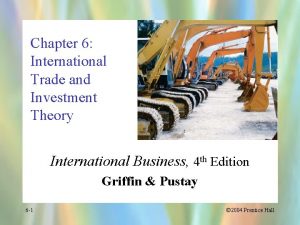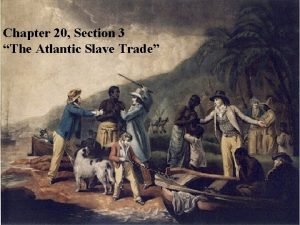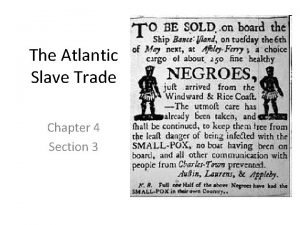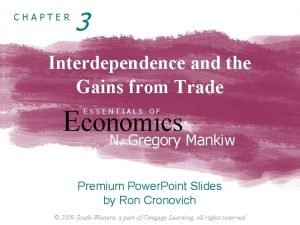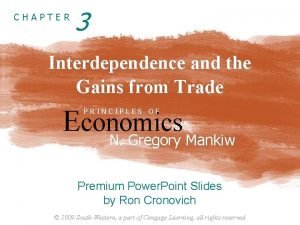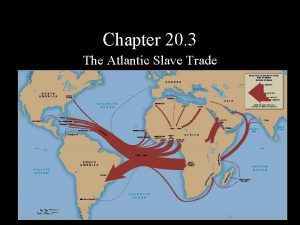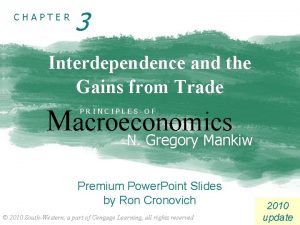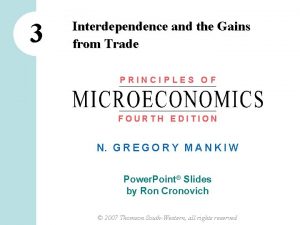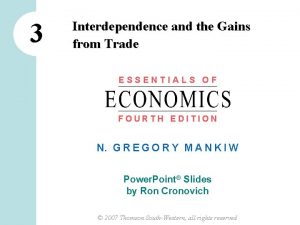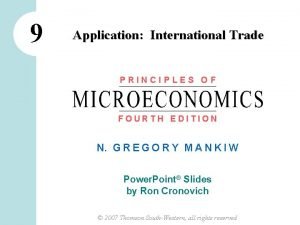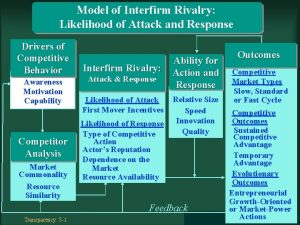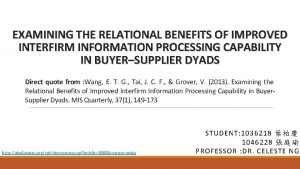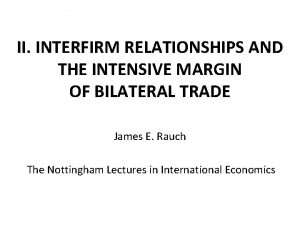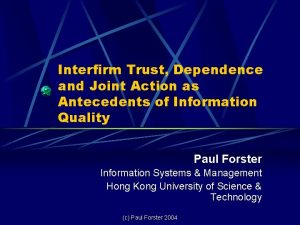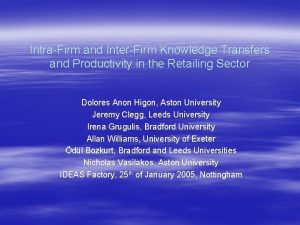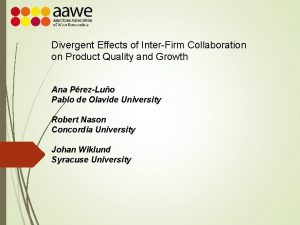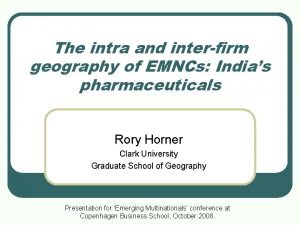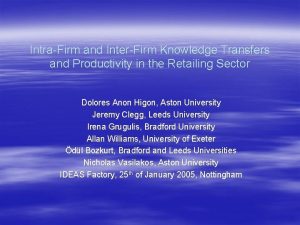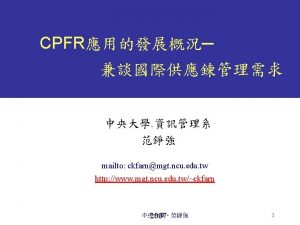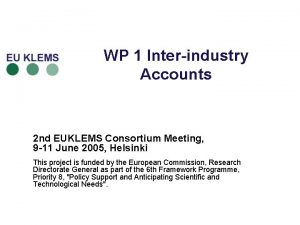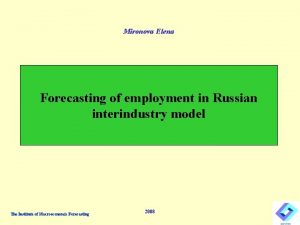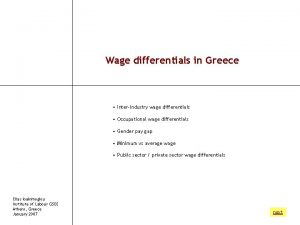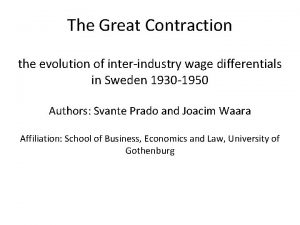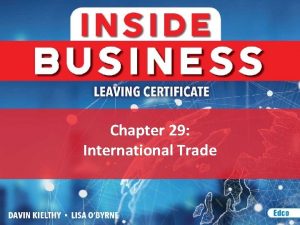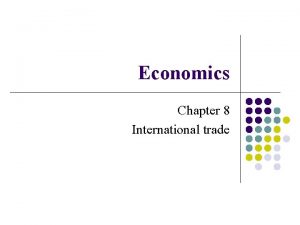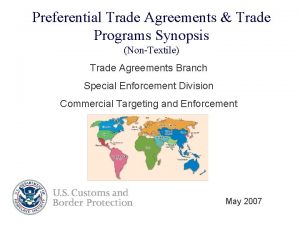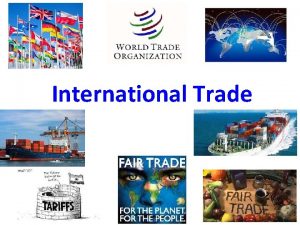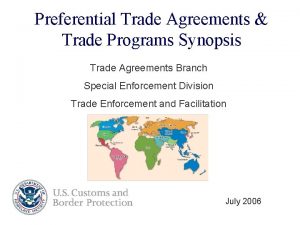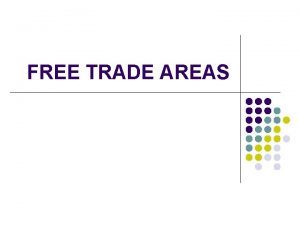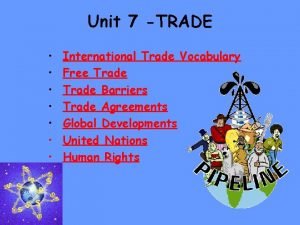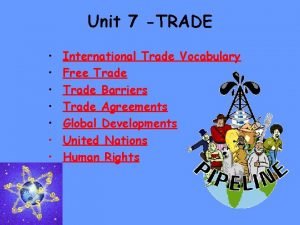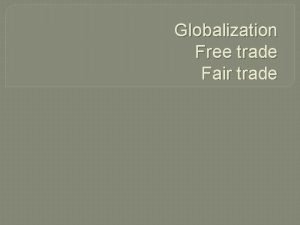Chapter 2 InterIndustry Trade Interindustry trade Interfirm trade





























- Slides: 29

Chapter 2 Inter-Industry Trade • Inter-industry trade • Inter-firm trade

What are the effects of trade in the long run, when countries differ in endowments? Heckscher-Ohlin model: The main differences with the Ricardian model: • Source of comparative advantage is the difference in resources endowments; • Two resources (factors of production) that are not specific to any industry: they are mobile across sectors • Technologies are the same across countries

Four theorems: • Heckscher-Ohlin theory: how resource endowments affect the pattern of trade • Rybczynski theory: how endowments affects production of a country • Stolper-Samuelson theory: how changes in relative price due to trade influence the distribution of gains within countries • Factor-Price Equalization theory: how trade affect the price of factors across countries

Heckscher-Ohlin theory Unit input requirements • Two countries Home and Foreign • kx and lx are the amount of • Two goods x and y K and L required to produce • Two endowments, labor (L) one unit of x and capital (K) • ky and ly are the amount of K and L required to produce • Perfect competition one unit of y • K and L are used to • Two constraints: produce x and y kx Q x + k y Q y K • Factors are mobile across sectors and immobile lx Q x + l y Q y L across countries Qx = K/kx - ky/kx Qy • Fixed coefficients Qx = L/lx - ly/lx Qy technologies (identical in the two countries)

Factor intensity: a key concept in the Heckscher-Ohlin model Technologies differ across industries, but are the same across countries Good x is capital intensive if • kx/lx > ky/ly, or kx/ky > lx/ly Good y is labor intensive because • ly/ky > lx/kx, or ly/lx > ky/kx Factor intensity is due to technologies and it is the same across countries

The production possibility frontier Qx = K/kx - ky/kx Qy Qx = L/lx - ly/lx Qy

How are endowments and outputs related? The Rybczynski theory • An increase in K (L) shifts the capital (labor)constraint to the right; • As a result, the production possibilities of good x (y) which uses more intensively capital (labor) increases.

An increase in K increases the production possibilities Qx = K/kx - ky/kx Qy

This means that : • over time, a country that increases the endowment of a factor, it increases also its production possibilities in the good that uses more intensively that factor; • countries that differ in endowments will produce goods that use their abundant endowment more intensively

How are goods prices and factor prices related? Stolper Samuelson theory Perfect competitive equilibrium in the factor market: • Px = kx r + l x w • Py = k y r + l y w By rearranging: • r = Px/kx - lx/kx w (1) • r = Py/ky - ly/ky w (2) Because we assume that y is the industry labor intensive and x is the industry capital intensive then the slope of the first (1) equation is lower than the slope of the second (2)

How are goods prices and factor prices related? r = Px/kx - lx/kx w (1) r = Py/ky - ly/ky w (2) )

Assume that Px price increases from Px 0 to Px 1 The rental rate increases to r 1 and the wage decreases to w 1 r = Px/kx - lx/kx w (1) r = Py/ky - ly/ky w (2) r 1 - r 0 Px 1 -Px 0

Stolper Samuelson theory • An increase in the price of a good will result in an increase of the nominal rate of return of the factor that is intensively used in the production of that good; • What is the effect on the real rate of returns? |(r 1 - r 0)| > |(Px 1 - Px 0)| |(w 1 - w 0)| > |(Px 1 - Px 0)| • Also the real rate will change according to the Stolper Samuelson theory • The SS theory applies both to changes in price over time in a certain country and to changes in price across countries at the same time

Stolper Samuelson theory Magnification Effect • The magnitude of the changes in nominal factor prices exceeds the magnitude of the changes of prices • Both real and nominal rate of return move in the same direction as a result of price changes

Two countries in the HO theory Assume that Foreign has the same technology as at Home (kx/lx) = (kx*/lx*) and (ky/ly) = (ky*/ly*) With (kx/lx) > (ky/ly) and (kx*/lx*) > (ky*/ly*) That is , x is the capital intensive industry and y is the labor intensive industry But countries differ in resources endowments • K/L > K*/L* That is, Home is capital abundant and Foreign is labor abundant

What are the production possibilities at Home?

And in the Foreign country? The slope of constraints are the same (same technology) but a different intercept reflects different resource endowment Home

Two countries in the HO theory: autarchy • PPF at Home is biased toward x that uses capital more intensively; • PPF in the Foreign country is biased toward y that uses labor more intensivel

Two countries in the HO theory: autarchy • Relative price of good x will be lower at Home: Px/Py = lx/ ly < P*x/P*y = kx/ky • This reflects the relative abundance of capital that is intensively used in the production of x ; • Rents (wages) at Home are lower (higher) than in Foreign (Stolper Samuleson);

What are the world prices with free trade and the patterns of trade? • As in the Ricardian model countries trade if prices are more favorable than in autarchy • The world relative supply is Qyw /Qxw with Qxw = Qx + Qx* and Qyw = Qy + Qy* • Remember that the autarchy relative price is equal in H to the slope of the labor constraint Px/Py = lx/ ly and in F to the slope of the capital constraint P*x/P*y = kx/ky

Pattern of trade in the HO model: • Countries will produce and export goods that are intensive in the country’s abundant factor endowment; • Countries will import goods that are intensive in the country’s scarce factor endowment

• Hence under free trade the price falls in a range in between the autarchy prices Py*/Px* < Pyw/Pxw < Py/Px or ky/kx < Pyw/Pxw < ly/lx • If price is lower than ky/kx none of the countries will produce good y ; If price is higher than ly/lx both countries produce only y

The world supply is a kinked curve: trade occurs only if world price is in between the two autarchy prices

What are the gains from trade? And the distribution of gains? • Like the Ricardian model, also in the HO model trade both countries gain because of an increase in their consumption possibilities ; • Unlike the Ricardian model, the HO model provides us with predictions about the domestic distribution of gains from trade • What happens to r and w when the countries open to trade?

• With free trade Home country will experience an increase in the relative price of x; This shifts upward equation 1: r increases and w decreases

• With free trade Foreign country will experience an increase in the relative price of y; this shifts upward equation 2: r decreases and w increases

• At Home, the capital abundant country, free trade implies an increase in the nominal and real rental rate paid to capital owners and a decreases in the real and nominal wage; capital owners gain and workers loose; • In the foreign country, the labor abundant country, free trade implies an increase in the nominal and real wage rate paid to workers and a decrease in the real and nominal rental rate; capital owners loose and workers gain.

Factor-Price Equalization theory • Factor-Price are equalized across countries as a result of trade; • In autarchy the capital (labor) abundant country has a relatively low rental (wage) rate • As home (Foreign) opens to trade, rents (wages) rise and wages (rents) fall; • Wages and rental rates continue to change up to when • P xw = w w l x + r w k x P y w = w w l y + r w k y

2. 2. 7 What are the effects of liberalizing trade policy?
 Trade diversion and trade creation
Trade diversion and trade creation Trade diversion and trade creation
Trade diversion and trade creation Trade diversion and trade creation
Trade diversion and trade creation The trade in the trade-to-gdp ratio
The trade in the trade-to-gdp ratio Fair trade not free trade
Fair trade not free trade Trade diversion and trade creation
Trade diversion and trade creation Tramp trade software
Tramp trade software Ted talk atlantic slave trade
Ted talk atlantic slave trade Chapter 6 theories of international trade and investment
Chapter 6 theories of international trade and investment The atlantic slave trade chapter 20 section 3
The atlantic slave trade chapter 20 section 3 Chapter 4 section 3 the atlantic slave trade
Chapter 4 section 3 the atlantic slave trade Chapter 3 interdependence and the gains from trade
Chapter 3 interdependence and the gains from trade Interdependence and the gains from trade chapter 3
Interdependence and the gains from trade chapter 3 The atlantic slave trade chapter 20 section 3
The atlantic slave trade chapter 20 section 3 Interdependence and the gains from trade
Interdependence and the gains from trade Interdependence and the gains from trade chapter 3
Interdependence and the gains from trade chapter 3 Chapter 3 interdependence and the gains from trade summary
Chapter 3 interdependence and the gains from trade summary Interdependence and the gains from trade
Interdependence and the gains from trade Chapter 9 application: international trade answers
Chapter 9 application: international trade answers Summary of the red tent
Summary of the red tent The great gatsby chapter 8 summery
The great gatsby chapter 8 summery Chapter 10 chapter assessment chemical reactions answers
Chapter 10 chapter assessment chemical reactions answers Chapter 11 assessment chemistry
Chapter 11 assessment chemistry Chapter 9 chemical reactions test answers
Chapter 9 chemical reactions test answers Similarity ratio definition
Similarity ratio definition Chapter 6 career readiness review
Chapter 6 career readiness review 7 ionic and metallic bonding
7 ionic and metallic bonding Chapter 9 surface water chapter assessment answer key
Chapter 9 surface water chapter assessment answer key Chapter 2 assessment physics answers
Chapter 2 assessment physics answers Chemistry central science 14th edition
Chemistry central science 14th edition








